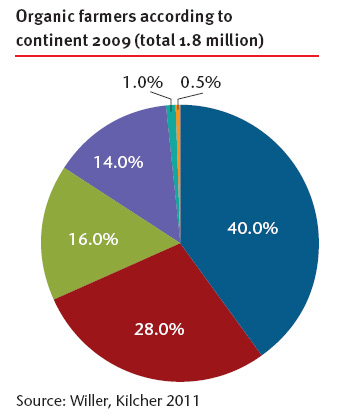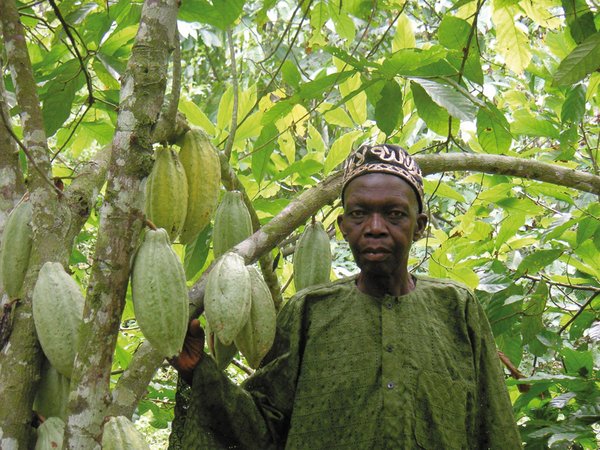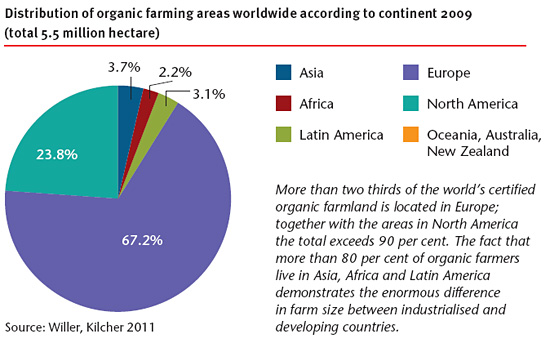 Download this article in magazine layout
Download this article in magazine layout
- Share this article
- Subscribe to our newsletter
A viable alternative?
Everyone concerned with the issue of food security is aware that the world’s rapidly rising population presents a major challenge. How much additional land remains available is still a matter of debate, but no-one disputes that the amount of land suitable for farming is limited. Many other resources essential to farmers are in similarly short supply. Experts therefore agree that the only viable type of farming is one that, rather than consuming these resources, uses them in ways that are sustainable as well as profitable. In 2050 such a system will have the task of feeding some nine billion people: what form will it need to take?
For IFOAM, the International Federation of Organic Agriculture Movements, it is clear that it can and must be an organic farming system. IFOAM’s vision is a global conversion from conventional to organic farming – with certification accompanied by marketing at higher prices, but probably for the most part without certification. In the Federation’s view, the conversion to organic farming not only makes sense but can also be profitable even without marketing at higher prices – especially if conventional farming internalises the external environmental costs that it incurs by assigning them directly to the conventionally produced agricultural products (see article "Standards and certification: means, not ends").
Organic agriculture without certification
If farmers were to convert to organic methods without selling their products at higher prices, this form of farming would have to achieve similarly high yields on the same area of land as other forms of sustainable agriculture without requiring significantly more extensive or expensive inputs. Otherwise many farmers would refuse to make this change.
The level of yields is a subject of heated scientific debate. It would appear that some crops achieve yields similar to those obtained in conventional agriculture, but others do not. In organic farming yields are closely related to the agro-climatic site conditions and the nutrient availability in the soil. Studies conclude that, depending on location and product, yields in organic systems are between 5 and 34 per cent lower (Seufert et al. 2012; de Ponti et al. 2012). If enough land was available, this could be offset by using more land – although this could encourage climate change unless animal production was reduced at the same time. As far as inputs are concerned, the labour factor in organic agriculture is particularly critical, since more labour is required for many crops – for example for weeding. A sufficient supply of inexpensive labour needs to be available; even in developing countries migration to the cities means that this is not necessarily the case.
The issue of nutrient supply must also be addressed. If synthetic fertilisers are banned in organic agriculture and only certain mineral ones can be used, regional nutrient cycles have to be established to produce enough organic fertiliser or compost to supply the same nutrients in sufficient quantity.
The question of prices is difficult to answer. In industrialised countries food has become a mass product that is often sold at rather low prices, even though consumers could easily afford to spend a significantly higher proportion of their household income on food. This trend has a highly detrimental impact on the sustainability of agriculture, since it creates pressure for food to be produced ever more cheaply. For many poor consumers in developing countries, by contrast, food prices are already so high as to be scarcely affordable. Many of these consumers would be unable to pay more for organic products than for ones produced conventionally or by other sustainable means.
There are various sustainable alternatives to resource-intensive agriculture. An integrated system of plant and animal production that is appropriate to the specific site conditions and uses integrated plant protection measures may also meet all the criteria of sustainability, but because it uses modest quantities of fertilisers and pesticides it cannot be classed as organic. An integrated crop production system can produce yields higher than those of an organic system and is therefore in direct competition with the organic method.
Opportunities for small-scale farmers
What does this mean for the production opportunities of small-scale farmers? As long as other forms of sustainable agriculture, as well as conventional farming, can produce more and do so even more cheaply, it is likely to be difficult for organic farming to prevail as the dominant or even the only form of agriculture in the short term. As a result, if certification and marketing according to organic standards are not possible, the opportunities for small-scale farmers must also be considered in the light of the alternatives.
The situation is different for certified organic farming, the products of which are marketed mainly for export to developed countries. This is where the great opportunity for organic farming lies. With an appropriate product and the right marketing opportunities it can be very profitable for farmers to operate organically. Moreover this opportunity not always needs to involve exporting to developed countries. In emerging and even developing countries there is increasingly a market – albeit a very small one at present – for organic products.
Rising demand for organic products
As the global demand for many food and other agricultural products rises, prices are increasing, too. This is creating opportunities for small-scale farmers to market their products beyond the local market. However, small farms in developing countries face a number of structural disadvantages. Because plots are small and productivity is low, only small quantities are produced; lack of knowledge of growing and processing techniques results in products of lower quality; poor organisation and limited access to market information make marketing of the products more difficult; lack of finance restricts investments.
Sales of organic products are rising steadily all over the world. Global trade in organic products has more than trebled since 1999: in 2010, according to FiBL (Reseaerch Institute of Organic Agriculture), sales of organic products were worth 44.5 billion euros (Willer, Kilcher 2012). Except in 2009, annual growth rates have consistently been in the two-digit range (Willer, Kilcher 2011). However, when viewed as a proportion of the total food market, it is clear that the organic market is still a niche one: in 2011 the organic share of the total food market in Germany was 3.7 per cent (BÖLW 2012), while the EU average in 2007 was 2 per cent (European Commission 2010).
 Most of the market for organic products is in the northern hemisphere: more than 90 per cent of sales take place in the industrialised countries, especially Europe and North America. However, as a result of the changing consumption patterns of a growing middle class, organically produced products are becoming increasingly popular in emerging and developing countries. It is therefore likely that demand for organically certified products will continue to grow – small-scale farmers can and should utilise these market trends. Through group certification schemes certified organic farming not only helps such farmers gain a foothold in the market; it can also help them become competitive suppliers and thus improve their position within the value chain.
Most of the market for organic products is in the northern hemisphere: more than 90 per cent of sales take place in the industrialised countries, especially Europe and North America. However, as a result of the changing consumption patterns of a growing middle class, organically produced products are becoming increasingly popular in emerging and developing countries. It is therefore likely that demand for organically certified products will continue to grow – small-scale farmers can and should utilise these market trends. Through group certification schemes certified organic farming not only helps such farmers gain a foothold in the market; it can also help them become competitive suppliers and thus improve their position within the value chain.
For example, by forming producer groups or farming for exporters on a contract basis, they can gain access to (international) markets for high-quality agricultural products. Often, too, group schemes make it easier for small-scale farmers to access farm inputs – for example, through prefinancing – and financial services, such as loans and saving schemes. Extension services to small-scale farmers enable them to meet organic farming standards by improving their growing, harvesting, storage and processing methods. The resulting higher quality enables them to access a niche market in which their products usually command higher prices. Contract farming frequently offers small-scale farmers a guaranteed outlet for their products. Farmers in producer groups benefit from the joint marketing of their products. In addition, the reduction in the use of external inputs (i.e. fertilisers and pesticides) also reduces the costs, which makes organic agriculture a farming system well adapted to the economic situation of smallholder farmers.
Challenges
However, there are also difficulties associated with the conversion to certified organic production. For example, there is no guarantee of higher prices, since there are no fixed price premiums like those associated with FairTrade certification and similar schemes. And the foregoing of sales options that results from being tied to one buyer or exporter can prove to be a disadvantage. The depth of knowledge required in organic farming also harbours risk: agricultural extension services must be consulted. Furthermore, the switch to organic farming imposes financial burdens in addition to the costs of certification itself – especially if, as is usually the case, higher prices cannot be obtained for the agricultural products during the two- to three-year conversion period. The greater labour intensity of organic farming can also result in additional costs.
Organic cocoa production in the DR Congo
Kivu Province is one of the regions most hit by the war that raged for more than ten years in the Democratic Republic of Congo. The war has largely destroyed local people’s livelihoods. To thousands of small-scale farmers in the crisis region growing certified organic cocoa offers a source of income and contributes to re-building the economy in the province.
In 2007 the company Esco Kivu launched a development partnership together with the Dutch DOEN Foundation and GIZ – on behalf of BMZ – with the aim of developing sustainable and economically viable organic cocoa production in Kivu. Esco Kivu supplied seedlings to the farmers and employed 50 field staff to train them in organic cocoa cultivation techniques. A quality monitoring system – a so-called Internal Control System – was established as the basis for a farmer group certifcation. Esco Kivu finances the certification and purchases the coffee and markets it. While the company cannot give a purchase guarantee to the farmers, it pays a fixed price premium for organic cocoa. Moreover, Esco Kivu offers farmers a savings scheme allowing them to deposit their income like in a bank and access it whenever they wish.
In the meantime more than 9,000 smallholder farmers have been certified according to EU and US-American organic farming standards
Depending on the site conditions, the yields of organic farmers may be lower than those of conventional ones. However, because the productivity level of small-scale farmers in developing countries is often very low, intensification of any type and appropriate advice – including a conversion to organic farming – can produce an initial increase in yields.
In order to reduce market and production risks, it is important that farmers diversify their products to minimise their vulnerability to market volatility. Additionally growing varieties that are adapted to local conditions can increase yield stability and provide resilience to weather fluctuations. Also, striking a balance between market-oriented and subsistence farming contributes to food security.
Even if organic farming does not immediately prove suitable as a global agricultural model, certified organic agriculture nevertheless provides small-scale farmers in developing countries with a viable alternative to conventional farming. It requires an enabling setting, including good agro-climatic conditions, adequate training and agricultural extension services and access to markets for high-quality products.
As organic agriculture in developing countries can contribute to food security and economic growth, GIZ supports capacity building not only of farmers (see Box above) but also of public and private agricultural extension services as well as local certification bodies.
References:
Bund Ökologische Lebensmittelwirtschaft e.V. (BÖLW) (2012): Zahlen Daten Fakten. Die Bio-Branche 2012, Berlin.
de Ponti, T., Rijk B., van Ittersum, M. K. (2012): The crop yield gap between organic and conventional agriculture. Agricultural Systems 108, 1 9.
European Commission (2010): An analysis of the EU organic sector.
Seufert, V., Ramankutty N., Foley J. A. (2012): Comparing the yields of organic and conventional agriculture. Nature doi: 10.1038/nature11069 (Published online 25 April 2012).
Willer, H., Kilcher L. (Eds.) (2011): The World of Organic Agriculture. Statistics and Emerging Trends 2011. FiBL-IFOAM Report. FiBL, Frick, IFOAM, Bonn.
Willer, H., Kilcher, L. (Eds.) (2012): The World of Organic Agriculture – Statistics and Emerging Trends 2012. FiBL, Frick, IFOAM, Bonn.
DR Stephan Krall
Stefanie Kirse
Deutsche Gesellschaft für Internationale Zusammenarbeit (GIZ) GmbH
Eschborn, Germany
Stephan.Krall@giz.de






Add a comment
Be the First to Comment